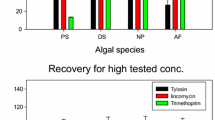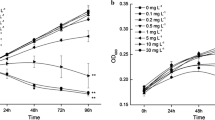Abstract
Anthropogenic water pollution is producing a challenge to the survival of phytoplankton populations. From an ecological point of view, the tolerance of these microorganisms to water pollution is of paramount importance since they are the principal primary producers of aquatic ecosystems. The adaptation of a common chlorophyta species (Scenedesmus intermedius) exposed to selected dose-response chloramphenicol (CAP) concentrations has been analyzed. A fluctuation analysis demonstrated that CAP-resistant cells arise due to spontaneous mutation which occurs randomly prior to the antibiotic exposure. CAP-inhibited growth and photosynthetic performance of algal cells at 0.28 mg/l, and the IC50(72) value was established in 0.10 mg/l for both parameters. The mutation rate from CAP sensitivity to resistance was 1.01 × 10−5 mutations per cell division, while the frequency of CAP-resistant allele in non-polluted environment was estimated to be 5.5 CAP-resistant mutants per 103 sensitive-cells. These results demonstrate that resistant mutants exhibit a diminished fitness until 5 mg/l of CAP, thus enabling the survival of microalgae population.

Similar content being viewed by others
References
Anderson LA, Smillie RM (1966) Binding of chloramphenicol by ribosomes from chloroplasts. Biochem Biophys Res Commun 23:535–539
Belfiore NM, Anderson SL (2001) Effects of contaminants on genetic patterns in aquatic organisms: a review. Mutat Res 489:97–122
Blanc H, Adams CW, Wallace DC (1981) Different nucleotide changes in the large rRNA gene of the mitochondrial DNA confer chloramphenicol resistance in two human cell lines. Nucleic Acids Res 9:5785–5795
Burns JL, Mendelman PM, Levy J, Stull TL, Smith AL (1985) A permeability barrier as a mechanism of chloramphenicol resistance in Haemophilus influenzae. Antimicrob Agents Chemother 27:46–54
Cairns J, Overbaugh J, Miller S (1988) The origin of mutants. Nature 335:142–145
Christensen AM, Ingerslev F, Baun A (2006) Ecotoxicity of mixtures of antibiotics used in aquacultures. Environ Toxicol Chem 25:2208–2215
Cohen JD, Eccleshall TR, Needleman RB, Federoff H, Buchferer BA, Marmur J (1980) Functional expression in yeast of the Escherichia coli plasmid gene coding for chloramphenicol acetyltransferase. Proc Natl Acad Sci USA 77:1078–1082
Costas E, Carrillo E, Ferrero LM, Agrelo M, García-Villada L, Juste J, López-Rodas V (2001) Mutation of algae from sensitivity to resistance against environmental selective agents: the ecological genetics of Dictyosphaerium chlorelloides (Chlorophyceae) under lethal doses of 3-(3,4-dichlorophenyl)-1,1-dimethylurea herbicide. Phycologia 40:391–398
Costas E, Flores-Moya A, Perdigones N, Maneiro E, Blanco JL, García ME, López-Rodas V (2007) How eukaryotic algae can adapt to the Spain’s Rio Tinto: a neo-Darwinian proposal for rapid adaptation to an extremely hostile ecosystem. New Phytol 175:334–339
Costas E, Flores-Moya A, Lopez-Rodas V (2008) Rapid adaptation of phytoplankters to geothermal waters is achieved by single mutations: were extreme environments ‘Noah’s Arks’ for photosynthesizers during the Neoproterozoic ‘snowball Earth’? New Phytol 180:922–932
Crow JF, Kimura M (1970) An introduction to population genetics theory. Harper and Row, New York
Dijkmans R, Kreps S, Mergeay M (1994) Poisson-like fluctuation patterns of revertants of leucine auxotrophy (leu-500) in Salmonella typhimurium caused by delay in mutant cell division. Genetics 127:353–359
Ehrlich PR (2001) Intervening in evolution: ethics and actions. Proc Natl Acad Sci USA 98:5477–5480
Falkowski PG, Raven JA (1997) Aquatic photosynthesis. Blackwell, Malden 384 pp
Flores-Moya A, Costas E, Bañares-España E, García-Villada L, Altamirano M, López-Rodas V (2005) Adaptation of Spirogyra insignis (Chlorophyta) to an extreme natural environment (sulphureous waters) through preselective mutations. New Phytol 165:655–661
García-Villada L, López-Rodas V, Bañares-España E, Flores- Moya A, Agrelo M, Martín-Otero L, Costas E (2002) Evolution of microalgae in highly stressing environments: an experimental model analyzing the rapid adaptation of Dictyosphaerium chlorelloides (Chlorophyceae) from sensitivity to resistance against 2,4,6-trinitrotoluene by rare preselective mutations. J Phycol 38:1074–1081
García-Villada L, Rico M, Altamirano M, Sánchez-Martín L, López-Rodas V, Costas E (2004) Occurrence of copper resistance mutants in the toxic cyanobacteria Microcystis aeruginosa: characterisation and future implications in the use of copper sulphate as algaecide. Water Res 38:2207–2213
Gaunt PS, McGinnis AL, Santucci TD, Cao J, Waeger P, Endris RG (2006) Field efficacy of florfenicol for control of mortality in channel catfish, Ictalurus punctatus (Rafinesque), caused by infection with Edwardsiella ictaluri. J World Aquac Soc 37:1–11
Halling-Sorensen B (2000) Algal toxicity of antibacterial agents used in intensive farming. Chemosphere 40:731–739
Holten Lützhoft HC, Halling-Sørensen B, Jørgensen SE (1999) Algal toxicity of antibacterial agents applied in Danish fish farming. Arch Environ Contam Toxicol 36:1–6
Huang ZY, Sun MY, Li S, Huang GL (2006) Pharmacokinetics of chloramphenicol in carp (Cyprinus carpio L.) after drug administration. Aquacult Res 37:1540–1545
ISO (1982) Water quality-algal growth inhibition test. ISO/DIN 8692. International Organization Standardization, Geneva
Kimura M, Maruyama T (1966) The mutational load with epistatic gene interactions in fitness. Genetics 54:1337–1351
Kirk JTO (1994) Light and photosynthesis in aquatic ecosystems, 2nd edn. Cambridge University Press, New York 256 pp
Levy SB (2002) Factors impacting on the problems of antibiotic resistance. J Antimicrob Chemother 49:25–30
López-Rodas V, Agrelo M, Carrillo E, Ferrero LM, Larrauri A, Martín-Otero L, Costas E (2001) Resistance of microalgae to modern water contaminants as the result of rare spontaneous mutations. Eur J Phycol 36:179–190
Lopez-Rodas V, Flores-Moya A, Maneiro E, Perdigones N, Marva F, García ME, Costas E (2007) Resistance to glyphosate in the cyanobacterium Microcystis aeruginosa as result of pre-selective mutations. Evol Ecol 21:535–547
Lopez-Rodas V, Marvá F, Costas E, Flores-Moya A (2008a) Microalgal adaptation to a stressful environment (acidic, metal-rich mine waters) could be due to selection of preselective mutants originating in non-extreme environments. Environ Exp Bot 64:43–48
Lopez-Rodas V, Marva F, Rouco M, Costas E (2008b) Adaptation of the chlorophycean Dictyosphaerium chlorelloides to stressful acidic, mine metal-rich waters as result of pre-selective mutations. Chemosphere 72:703–707
Lopez-Rodas V, Perdigones N, Marva F, Rouco M, García-Cabrera JA (2008c) Adaptation of phytoplankton to novel residual materials of water pollution: an experimental model analyzing the evolution of an experimental microalgae population under formaldehyde contamination. Bull Environ Contam Toxicol 80:158–162
Luria S, Delbrück M (1943) Mutations of bacteria from virus sensitivity to virus resistance. Genetics 28:491–511
Myers N, Knoll AH (2001) The biotic crisis and the future of evolution. Proc Natl Acad Sci USA 98:5389–5392
Nikaido H (1989) Outer membrane barrier as a mechanism of antimicrobial resistance. Antimicrob Agents Chemother 33:1831–1836
Palumbi SR (2001) Evolution—humans as the world’s greatest evolutionary force. Science 293:1786–1790
Pogo BGT, Pogo AO (1965) Inhibition by chloramphenicol of chlorophyll and protein synthesis and growth in Euglena gracilis. J Protozool 12:96–100
Quinn B, Gagne F, Blaise C (2008) An investigation into the acute and chronic toxicity of eleven pharmaceuticals (and their solvents) found in wastewater effluent on the cnidarian, Hydra attenuata. Sci Total Environ 389:306–314
Rigos G, Nengas I, Alexis M, Troisi GM (2004) Potential drug (oxytetracycline and oxolinic acid) pollution from Mediterranean sparid fish farms. Aquat Toxicol 69:281–288
Robinson I, Junqua G, Coillie RV, Thomas O (2007) Trends in the detection of pharmaceutical products, and their impact and mitigation in water and wastewater in North America. Anal Bioanal Chem 387:1143–1151
Sarmah AK, Meyer MT, Boxall ABA (2006) A global perspective on the use, sales, exposure pathways, occurrence, fate and effects of veterinary antibiotics (VAs) in the environment. Chemosphere 65:725–759
Schreiber U, Bilger W, Neubauer C (1986) Chlorophyll fluorescence as a non-intrusive indicator for rapid assessment of in vivo photosynthesis. In: Schulze ED, Caldwell MM (eds) Ecophysiology of photosynthesis: ecological studies. Springer, Berlin, pp 49–70
Siibak T, Peil L, Xiong L, Remme J, Mankinb A, Tenson T (2009) Erythromycin- and chloramphenicol-induced ribosomal assembly defects are secondary effects of protein synthesis inhibition. Antimicrob Agents Chemother 53:563–571
Spiess EB (1989) Genes in populations, 2nd edn. Wiley, New York
Takino M, Daishima S, Nakahara T (2003) Determination of chloramphenicol residues in fish meats by liquid chromatography–atmospheric pressure photoionization mass spectrometry. J Chromatogr A 1011:67–75
Tlsty TD, Margolin BH, Lum K (1989) Differences in the rates of gene amplification in nontumorigenic and tumorigenic cell lines as measured by Lüria and Delbruck fluctuation analysis. Proc Natl Acad Sci USA 86:9441–9445
Uriarte I, Farias A, Castilla JC (2001) Effect of antibiotic treatment during larval development of the Chilean scallop Argopecten purpuratus. Aquac Eng 25:139–147
Williams MA (1977) Quantitative methods in biology. North Holland, Amsterdam
Wollenberger L, Halling-Sorensen B, Kusk KO (2000) Acute and chronic toxicity of veterinary antibiotics to Daphnia magna. Chemosphere 40:723–730
Woodruff DS (2001) Declines of biomes and biotas and the future of evolution. Proc Natl Acad Sci USA 98:5471–5476
Acknowledgments
This work was supported by grants S-OSOS/AMB/0374 CAM; MAM 093/2002, CGL 2005-01938/BOS, CGL 2007-28853-E. Thanks are given to Eva Salgado for her technical support. We also wish to express our gratitude to David Bruhn for his review and stylistic changes to this manuscript.
Author information
Authors and Affiliations
Corresponding author
Rights and permissions
About this article
Cite this article
Sánchez-Fortún, S., Marvá, F., Rouco, M. et al. Toxic effect and adaptation in Scenedesmus intermedius to anthropogenic chloramphenicol contamination: genetic versus physiological mechanisms to rapid acquisition of xenobiotic resistance. Ecotoxicology 18, 481–487 (2009). https://doi.org/10.1007/s10646-009-0303-8
Received:
Accepted:
Published:
Issue Date:
DOI: https://doi.org/10.1007/s10646-009-0303-8




